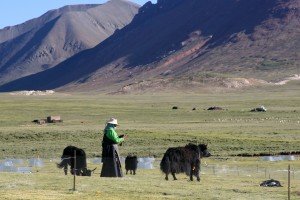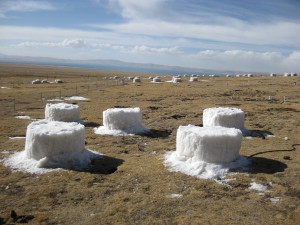20 December 2010
Spurred by climate change, plant die-offs could wreak havoc on Tibetian lifestyle
Posted by mohi

The Tibetan lifestyle may be severely affected future climate changes if fields livestock use to graze dry out. Photo courtesy of Chelsea Morgan.
For thousands of years the traditional herders of Tibet have lived among mountains, lakes and grasslands. Their livelihood– raising yak, sheep, and goats on the largest and highest plateau on the planet–is a precarious one.
As the planet warms, seasons that are normally dry on the Tibetan Plateau–winter and spring–are forecast to turn wet. At this elevation, the precipitation would fall as snow. Kelly Hopping, a graduate student in Ecology at Colorado State University, is worried this snow may disrupt the traditional life of these Tibetans.
Hopping’s work, presented in the Fall Meeting poster “Alpine ecosystem vulnerability to climate change on the Tibetan Plateau” (GC51D-0786), studies the health of the alpine steppe at Nam Tso, in the Tibetan Autonomous Region. Her work has found that as warming advances, the plateau–an area of 168 million hectares, 4 times the size of California–may switch from acting as a global carbon sink to a carbon source.
The switch from carbon sink to carbon source will likely be due to changes in the plateau’s dominant plant–Kobresia pygmaea. As it warms, Kobresia no longer absorbs as much carbon, which greatly reduces the ecosystem’s total carbon uptake. This perennial sedge grows in thick mats across the steppe. It has delicate roots and is sensitive to changes in soil moisture. Hopping has seen 50-percent of these plants die off–releasing their carbon stores into the atmosphere–in response to experimental warming treatments from 2009-2010. Yaks, the primary livestock, eat essentially only this plant, so the die-back is a severe loss for the herders.
Hopping is studying how predicted climate change will affect the plateau. Normally in this area, most of the rain falls in the summer monsoons. The soil retains enough moisture throughout the year for the plants. As it warms, however, soil is drying more quickly in response to heat. The precipitation in winter and spring isn’t enough to counteract the drying from heat. K. pygmaea‘s shallow roots have trouble reaching the water they need.
The shifting precipitation patterns wreak even more havoc outside of summer. During normal winters, the Tibetan Plateau sees little precipitation. However, climate change is bringing more winter and spring storms to the steppe, which at this elevation falls as snow. Under severe winter snowfall, livestock cannot reach the plants to forage and risk starvation.

Snow cakes, seen above, help Kelly Hopping of Colorado State understand how heavy snow affects grasslands in Tibet. Photo courtesy of Chelsea Morgan.
To study the affect of snow on the grasslands, Hopping and her co-researchers placed 64 “snow cakes” on the grass. The snow cakes resemble icy, over-sized hockey pucks, 1 meter across. Underneath these chilly micro-climates, Hopping monitored soil moisture, temperature, nitrate levels and carbon dioxide fluxes. Once the snow melted, she recorded the health and species composition of the plants underneath.
The snow cakes in Hopping’s study simulate the snow-fall of about 1 meter. This level is comparable to the storms of 1997-98, an especially bad year for the area. These severe snow falls so disrupted the grasslands that most yaks could not survive–many families lost 70% of their herds.
Intervention from the Chinese government, says Hopping, is doing little to help. For example, in the wake of the 97-98 snow storms, the only government aid at Nam Tso was a lottery to pass out sunglasses to help with snow-blindness. The government, claiming the grasslands are over-grazed, is now setting quotas on herd sizes, fencing pasturage and disrupting or discouraging the traditional communal grazing.
Most researchers, Hopping said, believe over-grazing is a minimal problem in this area, and that global warming is the true risk. Many believe, in fact, the government’s interference may be misguided. In her future work, Hopping is interested in seeing how the changes from a warming climate will work alongside the government’s management policies. Uncovering the interplay of these forces may, she hopes, help the Tibetans preserve their way of life.
–Danielle Venton is a science writing graduate student at UC Santa Cruz



 GeoSpace is a blog on Earth and space science, managed by AGU’s Public Information staff. The blog features posts by AGU writers and guest contributors on all sorts of relevant science topics, but with a focus on new research and geo and space sciences-related stories that are currently in the news.
GeoSpace is a blog on Earth and space science, managed by AGU’s Public Information staff. The blog features posts by AGU writers and guest contributors on all sorts of relevant science topics, but with a focus on new research and geo and space sciences-related stories that are currently in the news.
Overgrazing (as believed/ reported) by policy makers is not true, its an excuse to remove these herders from the alpine plateaus to make way for bigger projects. It is true that the soil warming/ moisture loss is accelerating the grassland degradation.
cheers………TNT
[…] On blogs.agu.org […]